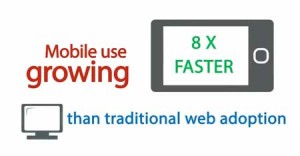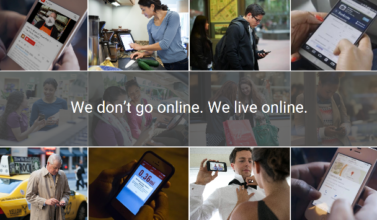
With the widespread adoption of smartphones and the increasing reliance on digital experiences, mobile marketing has become a prominent force in the marketing landscape. The ability to reach consumers directly on their palm-sized screens presents businesses with unique opportunities to influence consumer behaviour and shape purchasing decisions. Understanding the impact of mobile marketing is crucial for businesses looking to optimise their marketing strategies and engage with customers effectively.
In this in-depth guide, we will explore how mobile marketing shapes consumer buying behaviour and provide insights on how your business can leverage this knowledge to achieve superior results.
The Emergence of Mobile Marketing: A New Digital Frontier
“Mobile is becoming not only the new digital hub but also the bridge to the physical world. That’s why mobile will affect more than just your digital operations — it will transform your entire business.” – Thomas Husson
As a business owner, embracing mobile marketing can revolutionise the way you reach and engage with your customers. With smartphones becoming an integral part of our lives, it’s crucial for your business to adapt its marketing strategies to connect with consumers in this constantly evolving digital landscape.
Moreover, Marketing through mobile phones leverages the immediacy and convenience that smartphones provide. Your customers can access information, compare prices, and make purchases on the go, all while having their smartphones within reach. Mobile ads integrate seamlessly into these activities, offering timely solutions that cater to your customers’ needs.
6 Ways Mobile Marketing Affects Consumer Decision Making
This form of marketing plays a significant role in consumer decision-making by influencing various stages of the purchasing process. Here are 6 ways marketing through mobile phones influences customer buying behaviour:
1. Awareness
Mobile marketing helps create brand awareness by reaching potential customers through targeted ads on social media platforms, search engines, and apps. By consistently appearing on their screens, your business becomes more familiar and recognisable to consumers.
2. Research
Consumers often use their smartphones to research products and services before making a purchase. Marketing through cellphones enables businesses to provide relevant and easily accessible information through mobile-optimised websites, product reviews, and comparison tools, guiding customers towards an informed decision.
Recommended: Beginner’s Guide To A Mobile-Friendly Website
3. Personalisation
Through data analytics and advanced targeting techniques, mobile marketing allows businesses to deliver personalised content and promotions that resonate with individual preferences and needs. This level of personalisation increases the likelihood of conversion and fosters brand loyalty.
4. Location-based targeting
Marketing through mobile phones can utilise location-based services to deliver timely and contextually relevant offers, such as discounts or promotions when consumers are near a physical store. This encourages impulse purchases and drives foot traffic to brick-and-mortar locations.
5. Ease of purchase
Mobile marketing simplifies the purchasing process by integrating seamless payment options and reducing friction. With just a few taps, consumers can complete their transactions, increasing the likelihood of a sale.
6. Post-purchase engagement
Marketing through consumers’ cellphones continues to play a role even after a purchase, as businesses can send push notifications, follow-up emails, or in-app messages to maintain engagement, encourage repeat purchases, and solicit feedback.
By understanding and leveraging the role of mobile marketing in consumer decision-making, your business can create more effective marketing strategies that drive sales, increase customer satisfaction, and foster long-term loyalty.
Types of Mobile Marketing
This form of marketing can take many forms, depending on your specific goals and objectives. Here are some of the most common types used to influence consumer behaviour:
In-App Marketing
This type of marketing takes place within apps on consumers phones. It can be for your own brand or for other brands. For your brand, in-app marketing involves using banners, overlays, and inbox messages to promote products to app users. For other brands, ads can be displayed on popular apps or within your brand’s app, using formats such as banners, full-page ads, or videos. In-app marketing helps expand your customer base by advertising on widely used apps.
Mobile Push Marketing
This strategy involves sending marketing messages to portable devices using push technology. It enables you to share relevant information with users even when they’re not on your website or app. Mobile push notifications provide a simple and effective way to communicate with existing and potential customers.
SMS Marketing
SMS marketing entails running marketing campaigns through text messages. You can send promotions, alerts, offers, and more to customers’ phones. Text marketing campaigns often succeed because people usually carry their phones with them, making it hard to ignore notifications.
Mobile Marketing Through Social Media
With billions of users on social media platforms, these channels offer excellent opportunities for advertising and promoting your business. Social media marketing enables you to forge personal connections with consumers through Facebook ads, shoppable pins on Pinterest or promoted tweets.
Location-Based Marketing
This type of marketing aims to reach customers through their portable devices by using their location information. By creating tailored marketing campaigns according to customers’ locations, campaigns become more relevant and engaging.
QR Code Mobile Marketing
QR code marketing lets you generate a link to your website, encourage app downloads, request business reviews, or prompt newsletter signups. Customers can easily scan the QR code using their smartphone cameras. This versatile marketing approach allows you to engage more customers and is suitable for various marketing objectives.
Recommended: QR Codes and Marketing on Mobile
Final Thoughts
“Mobile is not the future, it is the now. Meet your customers in the environment of their choice, not where it’s convenient for you.” – Cyndie Shaffstall
Mobile marketing has emerged as a crucial component of digital marketing strategies. To stay ahead of the competition, businesses must recognise the impact of mobile devices on consumer choices and harness their potential. By utilising the unique features and capabilities of mobile technology, companies can design targeted campaigns that yield successful outcomes.
For expert guidance on your marketing strategy, reach out to WSI-eMarketing today. Discover how mobile marketing can enrich your customer’s experience and amplify your marketing endeavours.
Related Post
Effective Facebook Marketing...
With over 600 million users, Facebook represents the single most connected platform on...
- March 1, 2011
- By Nadine Thomas
- Latest Online Trends
Improved Marketing With QR...
You may have already seen QR codes in use, a little square containing what seems to be a...
- August 16, 2011
- By Rob Thomas
- Mobile Marketing
5 Mobile trends to master and...
The mobile web continues to grow at a rapid pace. Internet connectivity is improving and...
- July 30, 2014
- By Nadine Thomas
- Digital Marketing
Ashley Smith on The Buyers...
Ashley Smith is Partner Development Manager at ReachLocal and she specialises in PPC...
- December 18, 2015
- By Stephen Thomas
- Business Growth
Tamsin Talks Savvy Secrets...
Tamsin Fox-Davies is a small business evangelist with Constant Contact. She joined a...
- December 18, 2015
- By Stephen Thomas
Geotargeting – Why...
Geotargeting is a great way to get the most out of your PPC budget. Many...
- December 18, 2015
- By Stephen Thomas
- Digital Marketing











Leave a Comments